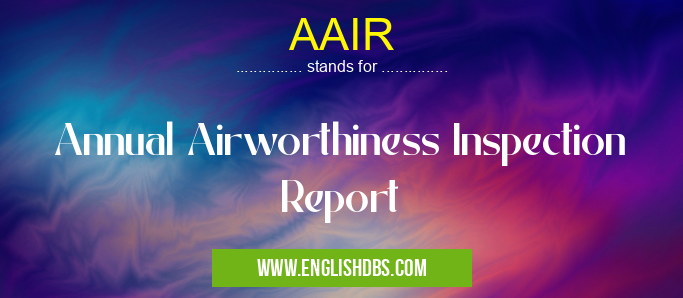What does AAIR mean in TRANSPORTATION
An Annual Airworthiness Inspection Report (AAIR) is a document required by several government aviation authorities that outlines the condition and safety of an aircraft. The purpose of this report is to ensure the airworthiness of the aircraft so that it can be operated safely and legally. It provides a comprehensive evaluation of the overall performance of an aircraft, including its components, systems, and operating environment.

AAIR meaning in Transportation in Governmental
AAIR mostly used in an acronym Transportation in Category Governmental that means Annual Airworthiness Inspection Report
Shorthand: AAIR,
Full Form: Annual Airworthiness Inspection Report
For more information of "Annual Airworthiness Inspection Report", see the section below.
AAIR Meaning
The acronym AAIR stands for Annual Airworthiness Inspection Report. This report is used by governmental authorities in order to judge the current airworthiness status of an aircraft mathematically. It provides detailed information about the current condition and safety of the aircraft, as well as potential deficiencies or areas where modifications may be necessary. It is important to remember that one must adhere strictly to all regulatory requirements for flying any given aircraft in order to maintain its airworthiness status at all times.
AAIR Full Form
The full form for AAIR is Annual Airworthiness Inspection Report. This type of report is used by government authorities such as the FAA and EASA in order to ensure that all airborne activities are safe. Such a report includes detailed evaluations on the state of an aircraft’s components, systems, and operating environment, making sure they are up-to-date with regulatory standards at all times.
Essential Questions and Answers on Annual Airworthiness Inspection Report in "GOVERNMENTAL»TRANSPORTATION"
What is an Annual Airworthiness Inspection Report (AAIR)?
An Annual Airworthiness Inspection Report (AAIR) is a review of the airworthiness of an aircraft which is conducted once a year in accordance with regulatory requirements. The purpose of this report is to ensure that the aircraft meets all applicable safety requirements and regulations, and is fit to continue operating safely.
What items are typically included in an Annual Airworthiness Inspection Report (AAIR)?
An Annual Airworthiness Inspection Report (AAIR) typically includes a comprehensive review of the airframe, engine, propeller, landing gear system, systems and components, avionics, operator’s manual and maintenance records.
How long does it take to complete an Annual Airworthiness Inspection Report (AAIR)?
The time required to complete an Annual Airworthiness Inspection Report (AAIR) varies depending on the complexity and size of the subject aircraft. Generally speaking it can take anywhere from 4-8 hours.
Who can perform an Annual Airworthiness Inspection Report (AAIR)?
An Annual Airworthiness Inspection Report (AAIR) can only be performed by a qualified technician or engineer who has extensive knowledge of aviation regulations and procedures.
Can I perform my own Annual Airworthiness Inspection Report (AAIR)?
No, you should not attempt to perform your own Annual Airworthiness Inspection Report (AAIR). This job requires specialized knowledge and qualifications that must be met in order for the results to be valid.
What types of repairs may be needed after an AAIR?
Based on the results of your annual airworthiness inspection report (AAIR), any necessary repairs or modifications will need to be made in order for the aircraft to remain safe for operation. These repairs may include but are not limited to issues with wiring or structural components, as well as operator error or abuse.
Why is completing an AAIR important?
Completing an annual airworthiness inspection report (AAIR) provides assurance that your aircraft meets all applicable safety requirements for continued operation. It also reduces potential risks associated with flight operations due to malfunctioning equipment or poor maintenance practices.
Are there penalties if my AAIR isn't done on time?
Yes, if your annual airworthiness inspection report (AAIIR) is not completed within the specified time frame then you may incur penalties from civil aviation authorities such as fines or cancellation of pilot licence privileges until compliance has been achieved. Therefore it's important to adhere to all timelines outlined for completion of this critical task.
What documents should I have ready before performing an AAIIR?
Before beginning your annual airworthiness inspection report you should have ready all pertinent documents such as maintenance records, technical log books, service bulletins/notices, copies of recent inspections and any other documentation pertaining to the aircraft’s condition such as test results or schematic diagrams etc. This will allow efficient completion of the task at hand with minimum fuss and disruption caused by searching for missing paperwork during inspection process itself.
Final Words:
Annual Airworthiness Inspection Reports are a crucial part of keeping any given aircraft safe and legal for flight operations. Governments rely on these documents in order to make sure that all aircraft comply with regulations at all times in order to avoid accidents or incidents while flying. As such, it’s important for pilots and other aviation personnel to understand what these reports contain and how they help maintain safe flight operations.
AAIR also stands for: |
|
| All stands for AAIR |
